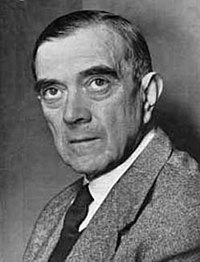Corrado Gini
Corrado Gini | |
|---|---|
 | |
| Born | May 23, 1884 |
| Died | March 13, 1965 (aged 80) |
| Citizenship | Italian |
| Alma mater | University of Bologna |
| Known for | Gini coefficient |
| Scientific career | |
| Fields | |
| Institutions | |
Corrado Gini (23 May 1884 – 13 March 1965) was an Italian
Career
Gini was born on May 23, 1884, in
Gini's scientific work ran in two directions: towards the social sciences and towards statistics. His interests ranged well beyond the formal aspects of statistics—to the laws that govern biological and social phenomena.
His first published work was Il sesso dal punto di vista statistico (1908). This work is a thorough review of the natal sex ratio, looking at past theories and at how new hypothesis fit the statistical data. In particular, it presents evidence that the tendency to produce one or the other sex of child is, to some extent, heritable.
He published the Gini coefficient in the 1912 paper Variability and Mutability (Italian: Variabilità e mutabilità).[2][3] Also called the Gini index and the Gini ratio, it is a measure of statistical dispersion intended to represent the income inequality within a nation or other group.
In 1910, he acceded to the Chair of Statistics in the University of Cagliari and then at Padua in 1913.
He founded the statistical journal Metron in 1920, directing it until his death; it only accepted articles with practical applications.[4]
He became a professor at the Sapienza University of Rome in 1925. At the University, he founded a lecture course on sociology, maintaining it until his retirement. He also set up the School of Statistics in 1928, and, in 1936, the Faculty of Statistical, Demographic and Actuarial Sciences.
Under fascism
In 1926, he was appointed President of the
In 1927 he published a treatise entitled The Scientific Basis of Fascism.[6]
In 1929, Gini founded the Italian Committee for the Study of Population Problems (Comitato italiano per lo studio dei problemi della popolazione) which, two years later, organised the first Population Congress in Rome.
A eugenicist apart from being a demographer, Gini led an expedition to survey Polish populations, among them the Karaites. Gini was throughout the 20s a supporter of fascism, and expressed his hope that Nazi Germany and Fascist Italy would emerge as victors in WW2. However, he never supported any measure of exclusion of the Jews.[7][8] Milestones during the rest of his career include:
- In 1933 – vice president of the International Sociological Institute.
- In 1934 – president of the Italian Genetics and Eugenics Society.
- In 1935 – president of the International Federation of Eugenics Societies in Latin-language Countries.
- In 1937 – president of the Italian Sociological Society.
- In 1941 – president of the Italian Statistical Society.
- In 1957 – Gold Medal for outstanding service to the Italian School.
- In 1962 – National Member of the Accademia dei Lincei.[9]
Italian Unionist Movement
On October 12, 1944, Gini joined with the Calabrian activist
Organicism and nations
Gini was a proponent of
Honours
The following honorary degrees were conferred upon him:
- Economics by the Catholic University of the Sacred Heart in Milan (1932),
- Sociology by the University of Geneva (1934),
- Sciences by Harvard University (1936),
- Social Sciences by the University of Cordoba, Argentine (1963).
Partial bibliography
- Il sesso dal punto di vista statistica: le leggi della produzione dei sessi (1908)
- Sulla misura della concentrazione e della variabilità dei caratteri (1914)
- Quelques considérations au sujet de la construction des nombres indices des prix et des questions analogues (1924)
- Memorie di metodologia statistica. Vol.1: Variabilità e Concentrazione (1955)
- Memorie di metodologia statistica. Vol.2: Transvariazione (1960)
- — (March 1927). "The Scientific Basis of Fascism". Political Science Quarterly. 42 (1): 99–115. JSTOR 2142862.
References
- ^ a b c d e Aaron Gillette. Racial theories in fascist Italy. London, England, UK; New York, New York, USA. Pp. 40.
- ^ Gini, C. (1909). "Concentration and dependency ratios" (in Italian). English translation in Rivista di Politica Economica, 87 (1997), 769–789.
- ^ Gini, C (1912). Variabilità e Mutuabilità. Contributo allo Studio delle Distribuzioni e delle Relazioni Statistiche. Bologna: C. Cuppini.
- ^ "Corrado Gini's Biography". Società Italiana di Statistica (SIS). Archived from the original on 2016-11-06. Retrieved 2016-11-05.
- ^ "Tales of Statisticians | Corrado Gini". www.umass.edu. Archived from the original on 2018-08-21. Retrieved 2018-08-21.
- ^ The Scientific Basis of Fascism, Political Science Quarterly Vol.42, No 1, March 1927 pp. 99-115.
- ^ Mikhail Kizilov, The Karaites of Galicia: An Ethnoreligious Minority Among the Ashkenazim, the Turks, and the Slavs, 1772-1945, BRILL, 2009 pp.278ff.
- ^ Riccardo Calimani, Storia degli ebrei italiani, vol.3, Mondadori 2015 p.583.
- JSTOR 2343927.
- ^ a b Aaron Gillette. Racial theories in fascist Italy. London, England, UK; New York, New York, USA. Pp. 41.
External links
- Biography Of Corrado Gini at the Metron, the statistics journal he founded.
- Paper on "Corrado Gini and Italian Statistics under Fascism" by Giovanni Favero June 2002
- A. Forcina and G. M. Giorgi "Early Gini’s Contributions to Inequality Measurement and Statistical Inference." JEHPS mars 2005
- Another photograph
